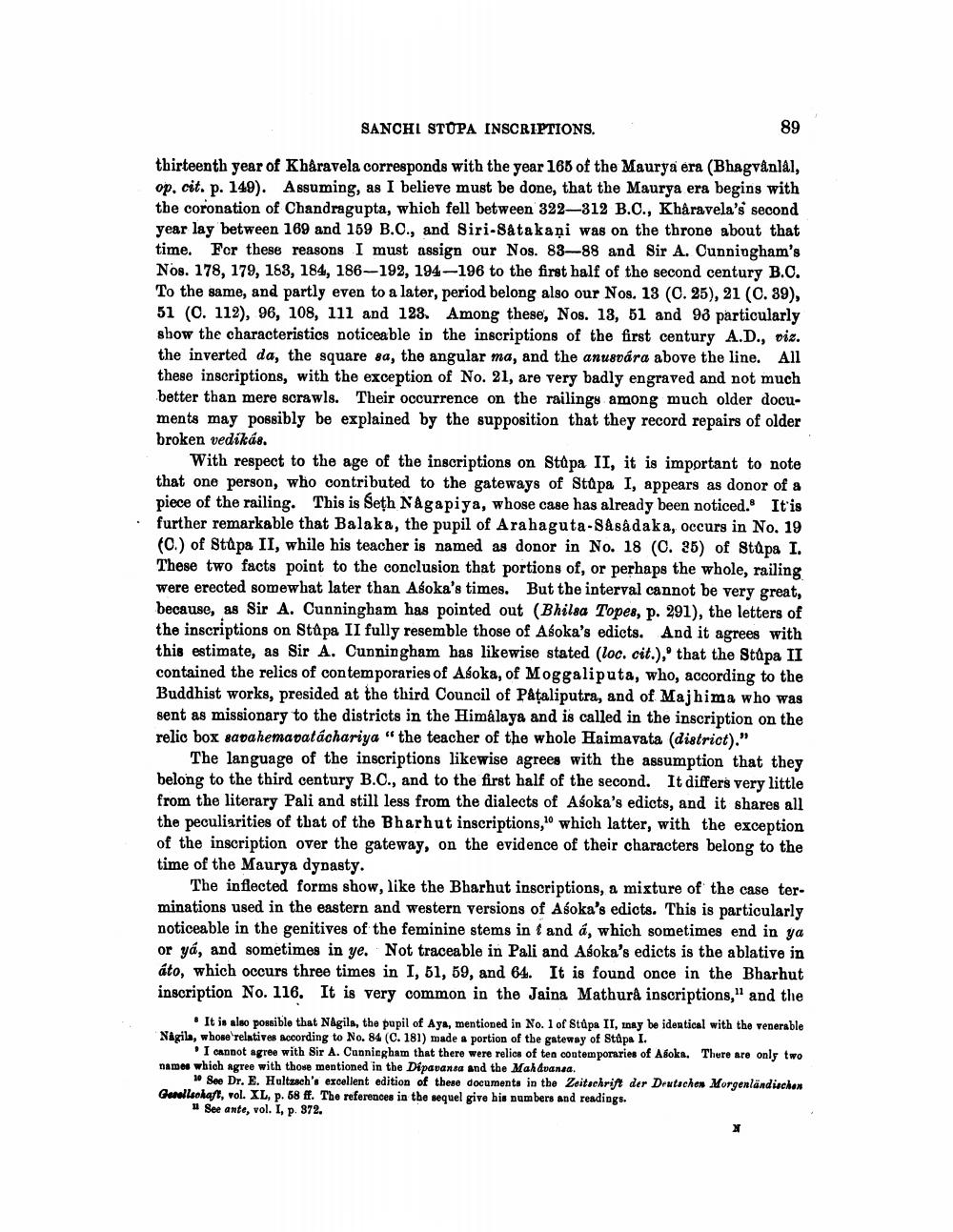________________
SANCHI STOPA INSCRIPTIONS.
89
thirteenth year of Khåravela corresponds with the year 168 of the Maurya era (Bhagvanlai, op. cit. p. 149). Assuming, as I believe must be done, that the Maurya era begins with the coronation of Chandragupta, which fell between 322-312 B.C., Khåravela's second year lay between 169 and 169 B.O., and Siri-Satakaņi was on the throne about that time. For these reasons I must assign our Nos. 83-88 and Sir A. Cunningham's Nos. 178, 179, 183, 184, 186-192, 194-196 to the first half of the second century B.C. To the same, and partly even to a later, period belong also our Nos. 13 (0.25), 21 (C. 39), 51 (. 112), 96, 108, 111 and 123. Among these, Nos. 13, 51 and 98 particularly show the characteristics noticeable in the inscriptions of the first century A.D., diz. the inverted da, the square sa, the angular ma, and the anusvára above the line. All these inscriptions, with the exception of No. 21, are very badly engraved and not much better than mere scrawls. Their occurrence on the railings among much older documents may possibly be explained by the supposition that they record repairs of older broken vedikás.
With respect to the age of the inscriptions on Stupa II, it is important to note that one person, who contributed to the gateways of Stapa I, appears as donor of a piece of the railing. This is Seth Nagapiya, whose case has already been noticed. It is further remarkable that Balaka, the pupil of Arahaguta-Sasadaka, occurs in No. 19 (.) of Stupa II, while his teacher is named as donor in No. 18 (C. 35) of Stupa I. These two facts point to the conclusion that portions of, or perhaps the whole, railing were erected somewhat later than Asoka's times. But the interval cannot be very great, because, as Sir A. Cunningham has pointed out (Bhilsa Topes, p. 291), the letters of the inscriptions on Stapa II fully resemble those of Asoka's edicts. And it agrees with this estimate, as Sir A. Cunningham has likewise stated (loc. cit.)," that the Stapa II contained the relics of contemporaries of Asoka, of Moggaliputa, who, according to the Buddhist works, presided at the third Council of Pataliputra, and of Majhima who was sent as missionary to the districts in the Himalaya and is called in the inscription on the relic box savahemapatáchariya "the teacher of the whole Haimavata (district)."
The language of the inscriptions likewise agrees with the assumption that they belong to the third century B.C., and to the first half of the second. It differs very little from the literary Pali and still less from the dialects of Asoka's edicts, and it shares all the peculiarities of that of the Bharhut inscriptions, which latter, with the exception of the inscription over the gateway, on the evidence of their characters belong to the time of the Maurya dynasty.
The inflected forms show, like the Bharhut inscriptions, a mixture of the case terminations used in the eastern and western versions of Asoka's edicts. This is particularly noticeable in the genitives of the feminine stems in i and á, which sometimes end in ya or ya, and sometimes in ye. Not traceable in Pali and Asoka's edicts is the ablative in áto, which occurs three times in I, 51, 59, and 64. It is found once in the Bharhut inscription No. 116. It is very common in the Jaina Mathura inscriptions," and the
. It is also possible that Nagils, the pupil of Aya, mentioned in No. 1 of Stúpa II, may be identical with the venerable Nagila, whose relatives according to No. 84 (C. 181) made a portion of the gateway of Stúpa I.
I cannot agree with Sir A. Cunningham that there were relics of ten contemporaries of Asoka. There are only two names which agree with those mentioned in the Dipavansa and the Maldvana.
* See Dr. E. Hultzsch's excellent edition of these documents in the Zeitschrift der Deutschen Morgenländischen Gerollschaft, vol. XL, p. 58 ff. The references in the sequel give his numbers and readings.
1 See ante, vol. I, p. 372.




